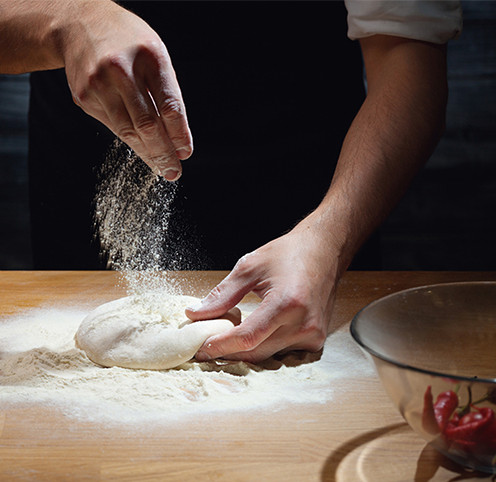So you want to open a pizzeria? These are the 5 key solutions
Everyone finds it hard to resist a crispy slice of pizza. It’s so hard that sometimes you may find yourself dreaming about owning your own pizza place. The first thought that comes to mind is: Where should you start? That leads to plenty of other questions. We will try to answer the most important one: What do you need to develop a successful pizzeria?
The most popular dish of all
In Lithuania, like in the rest of the world, pizza is the most popular dish in restaurants and takeout orders with over 3 million pizzas sold per year. That is why since 1987, February 9th has been known as International Pizza Day. This was the date when the largest pizza in the world was made in Florida and registered in the Guinness World Records.
“The popularity of pizza is confirmed by data from the start of 2021 on the Meniu.lt platform. In Lithuania there are 92 brands that have opened 161 pizzerias,” stated Laurynas Mažuolis, Head of Meniu.lt, the largest restaurant guide in Lithuania. He added that the general scope of this dish is even wider, since pizzerias are not the only places that serve pizza. They can also be ordered from other types of catering establishments.
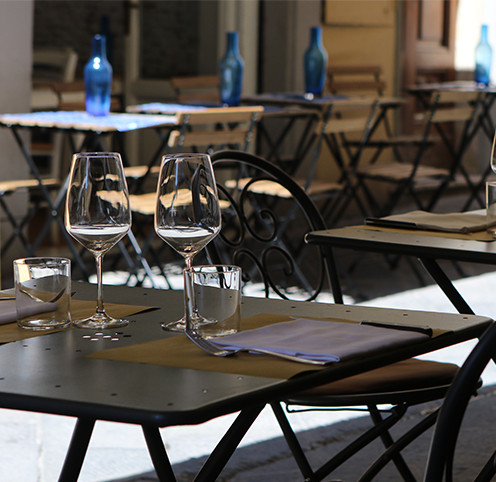
What makes pizza so popular? First of all, it is one of the most user-friendly and the most adaptable of dishes. By combining different types of flour to make the base and adding the preferred toppings, we can adapt the pizza to any preferences and the age groups of our customers. It’s even suitable for health enthusiasts. Pizza also has a certain social image: it is a meal that we share with our family, friends and colleagues. It often becomes the main topic of a party, as everyone can joins in to make it from scratch or by combining the ingredients that are available in a pizzeria.
Strategy and concept of a successful pizzeria
“A pizzeria is one of the easiest concepts to implement, as it is typically adapted for both on-site dining and take-away service,” said Ieva Vaičiūnaitė, Marketing Specialist at the gastronomic consulting agency Kitchen Rules. “The main challenges in creating this type of business are a clear business strategy and a complete concept.”
The consultant suggests creating a story that the pizzeria will tell its loyal clients. You should first ask yourself a few questions: Are you going to make the cheapest pizza? Will the shape of your pizza be unique? Maybe you’re planning to use only authentic Italian ingredients? Are you going to make Neapolitan pizza? These and similar questions will help you outline the identity of your future business. Once you find the answers, you should adhere to your chosen direction at all stages during the development of the pizzeria. This will affect the arrangement of the restaurant, product choice, taste creation, communication planning and activities on social networks.
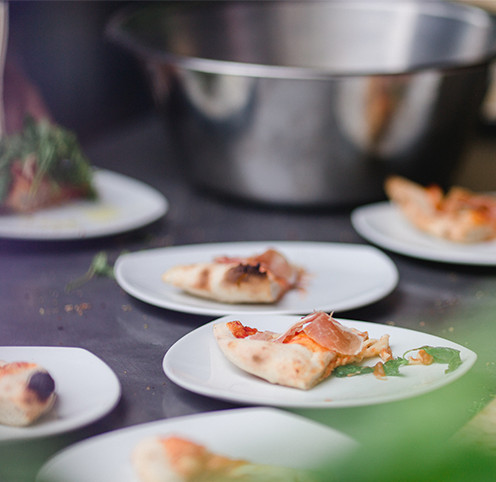
Type of pizzeria
There are two main types of pizzerias: a restaurant, where diners are invited to come in and sit at a table; or a take-away, where the products are only available for takeout.
There must be a story behind your pizzeria: for example, if you have something to be proud of such as a unique recipe or an innovative way of making pizza, the rationale for opening a restaurant is clear. Next, you should decide on the opening hours: Are you going to accept orders during the day, or will you focus on greeting your clients with a dinner menu.
Dieninis formatas dažniausiai neapsieina be pietų paslaugos: juk svečiai kasdien nevalgys vien picų. Būkite pasiruošę, kad dienos pietų organizavimui gali prireikti apie 30% turimų žmogiškųjų resursų: reikės kurti patiekalus, ieškoti naujų produktų, skirti dėmesio rinkodarai ir komunikacijai. Jeigu orientuojatės į vėlyvesnį laiką, tuomet tradicinė pica turės tapti ir visos vakaro patirties ašimi. Gal jūsų picos stebins formomis ar spalvomis? Gal derės prie indų serviruotės, apšvietimo ir specialios muzikos? O gal picą atneš pats šefas ir svečio akyse ją papuoš degančiu, garuojančiu ar mirksinčiu akcentu? Visa tai – jau kūrybinė dalis.
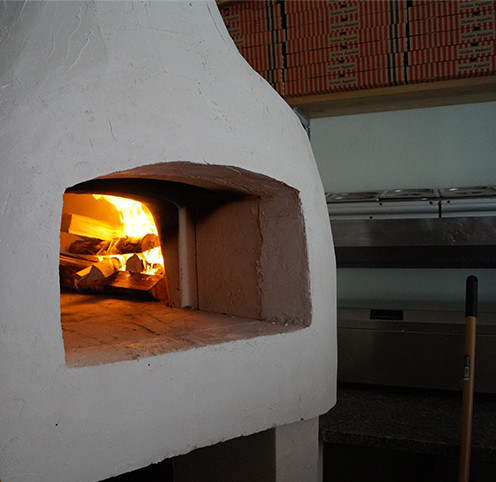
A take-away pizzeria consists of 3 main elements:
- Location;
- Ordering system;
- A tasty pizza with good value for money.
A convenient and appealing ordering system is a very important step in determining the success of your first orders. The pizzas should be beautifully photographed to look really mouthwatering. If you don’t have the funds to create your own ordering platform, you can always join some of the already established online systems.
Pizzeria equipment and technologies
“The technology employed in the pizzeria may seem like one of the easiest tasks, because everyone knows the process of making a pizza. However, it is important to consider that baking pizzas requires extreme speed. Therefore, the workplace must be comfortable and well-planned, while considering the intended number of employees,” advised Jurgita Viltrakienė, Technologist at the gastronomic consulting agency Kitchen Rules. The number of jobs can be anticipated by estimating both the sales and the planned activities. “If the pizzeria will prepare all the raw materials on-site – chopping the vegetables and roasting the meat – larger premises will be needed to accommodate more staff and equipment,” explained the Technologist.
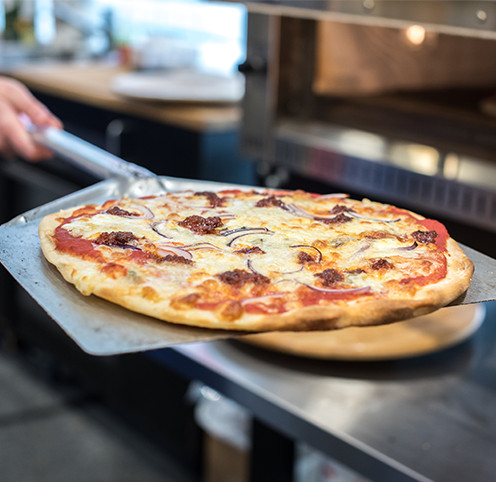
The amount and type of equipment will also depend on the scope of the processes, but every pizzeria must have some basic tools: a pizza oven, dough mixer, dough roller and a pizza prep counter. We will briefly discuss each of these items.
Pizza ovens. Electric ovens are the most popular choice, since electricity is already available in most premises while a finding a gas supply might be a problem. Nonetheless, a wood-fired oven gives pizzas a special taste. It can also serve as an interior feature that attracts the attention of guests and emits appetising aromas. However, the size of the premises will need to be considered, as wood-fired ovens are usually very large. They are also complicated and expensive to relocate, so these ovens are usually chosen by owners of pizzerias located in their own or long-term rental premises.
Dough mixers. After estimating the quantity of pizzas that will be baked, you can choose a suitable mixer with one or two mixing speeds (a two-speed mixer will prepare the dough more efficiently). You can also choose a single-phase or a three-phase dough mixer. If there is a three-phase connection available in the premises, it is advisable to choose a three-phase mixer. It will ensure more stable operations and reduce the difficulties in the case of higher loads.
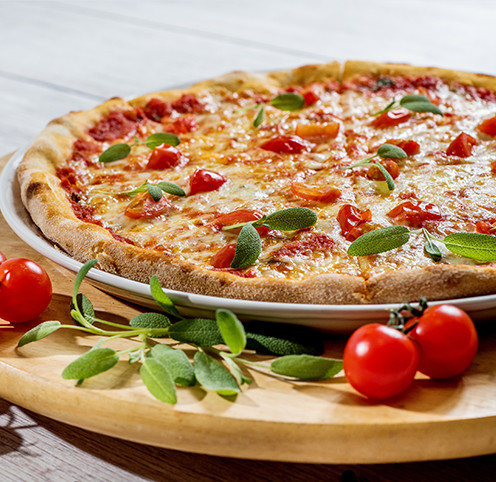
Pizza dough roller. An important consideration is the diameter of the pizza: the most popular sizes are 32 and 42 cm. Pay attention to the manufacturer, because the dough roller is a ‘needy’ device: while forming the dough, some residue falls between the gears that rotate the roller. The dough then hardens and can break the mechanism. Therefore, this equipment must be very durable.
Pizza prep counter. This is another case where the reliability of the manufacturer is very important. The most popular counters are the ones that have convenient drawers. They can be used to store GN containers with suitable compartments for various products. Counters with doors are more spacious, but they are often less convenient.
The most suitable premises
After defining the type of your pizzeria you want to open and assessing your equipment requirements, you will need to find the perfect premises. The space must be appropriate to the expected number of employees and production processes.
If you have chosen a take-away format, a good location is one of the most important elements. The restaurant should be visible, as well as easy to reach by car and on foot. Then you must create a memorable brand and provide a visual identity that clearly reflects your field of activity: both the colour range and the presentation must be understandable to your pizza lover.
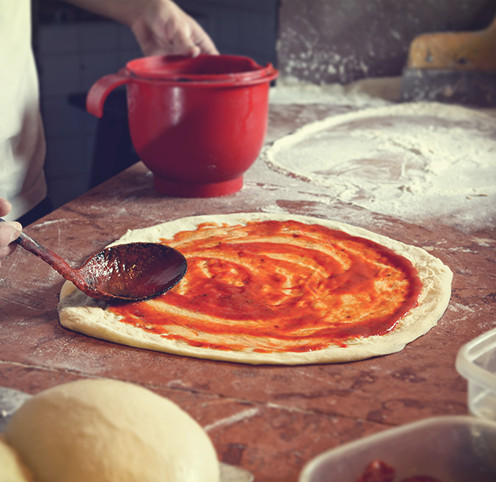
The right communication format
While the installation processes are underway, you should also be preparing the ‘face’ and the ‘voice’ of the pizzeria that will identify this new player in the gastronomy market. During this stage, it is important to choose platforms that will grab the attention of your customers. First and foremost, the internet heavyweights are the main sources of knowledge in this field: Google My Business, Tripadvisor and Meniu.lt. You can create and manage these accounts yourself, or you can rely on the skills of a professional consultant.
If you have the opportunity to invest even a small amount, social networks like Instagram and Facebook should be added to your toolkit. If you are planning to open more than 5 pizzerias, it will be worthwhile to use the national media and advertising channels: Google Keywords, radio, print and even TV project sponsorships. If you are responsible for strengthening the image of a large network (with over 15 locations), combining the above communication channels with outdoor advertising will add the perfect final touch.
If you really have something to say, use a public platform. In the catering business, communication is an important tool, because gastronomy evokes a lot of emotions. Few people remain indifferent when it comes to food: people have different tastes with strong opinions and endless suggestions. Therefore, the most important step before taking any further action is to formulate a clear strategy that allow you to adhere to a successful business plan.
